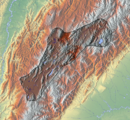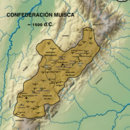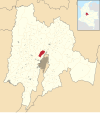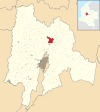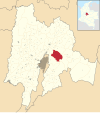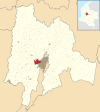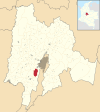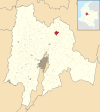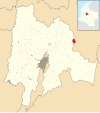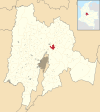Muisca art
During the preceramic era, the people of the highlands produced petrographs and petroglyphs representing their deities, the abundant flora and fauna of the area, abstract motives and anthropomorphic or anthropo-zoomorphic elements.
During this time, the oldest existing form of constructed art was erected; the archaeoastronomical site called El Infiernito ("The Little Hell") by the catholic Spanish conquistadors.
This ceremony, performed by xeques (priests) and caciques wearing feathered golden crowns and accompanied by music and dance, took place on a raft in Lake Guatavita, in the northern part of the flat Bogotá savanna.
The conquistador who made first contact with the Muisca, Gonzalo Jiménez de Quesada, wrote in his memoires about a skilled and well-organised civilisation of traders and farmers.
Friar Pedro Simón described the relation between art and the religion and later contributions in the analysis of the various artforms have been made by Alexander von Humboldt, Joaquín Acosta and Liborio Zerda in the 19th century, Miguel Triana, Eliécer Silva Celis and Sylvia M. Broadbent in the 20th century and modern research is dominated by the work of Carl Henrik Langebaek Rueda, Javier Ocampo López and many others.
The central highlands of the Eastern Ranges of the Colombian Andes, called Altiplano Cundiboyacense, was inhabited by indigenous groups from 12,500 BP, as evidenced from archaeological finds at rock shelter El Abra, presently part of Zipaquirá.
Settlement in the early millennia of this Andean preceramic age was mainly restricted to caves and rock shelters, such as Tequendama in present-day Soacha, Piedras del Tunjo in Facatativá and Checua that currently is part of the municipality Nemocón.
Abundant evidence for the domestication of guinea pigs has been found at Tequendama and Aguazuque where the small rodents formed part of the diet of the people, who consumed mainly white-tailed deer, hunted on the plains surrounding the various lakes and rivers.
This site, the oldest remaining of constructed art, dated at 500 BC, formed an important place for religious rituals and festivities where great quantities of the alcoholic drink chicha was consumed.
The Early Muisca Period, roughly defined from 800 to 1000 AD, showed an increase in long-distance trade with the Caribbean coastal indigenous populations, mummification and the introduction of goldworking.
[7] Researcher Gerardo Reichel-Dolmatoff theorised in his book Orfebrería y chamanismo in 1988 that the basis for the beards and moustaches may have been the abundant fish present on the Altiplano and essential part of the diet of the Muisca and their ancestors, as evidenced in Aguazuque; Eremophilus mutisii.
[8][9][10] Frogs (iesua, meaning "food from the Sun" in Muysccubun) and toads were important animals in the concept of nature and the relation with the spiritual world for the Muisca.
[11] They represented the start of the rainy season, which is illustrated in the use in the Muisca calendar; the symbols for the first (ata), ninth (aca) and holy twentieth (gueta) month of the years are derived from toads.
[15] Based on the stylistic variability and metallurgic technology analysed in Muisca goldworking, three processes have been concluded; With the indigenous groups closer to the Caribbean Coast, the people traded highly valuable sea snails.
The skilled goldworking of the Muisca formed the basis for the legend of El Dorado that became widespread among the Spanish conquistadors; this eventually drew them into the heart of Colombia—an ill-fated expedition that took almost a year and cost the lives of about 80% of their men.
[35] The tunjos served three purposes; as decoration of temples and shrines, for offering rituals in the sacred lakes and rivers in the Muisca religion, and as pieces in funerary practices; to accompany the dead to the afterlife.
[36] The precious metals silver and gold were not common in the Eastern Ranges, while copper was mined in Gachantivá, Moniquirá and in the mountains to the south of the Bogotá savanna at Sumapaz.
The process of elaborating the fine filigree figures took place by creating a mold of obsidian, shale or clay, filling the open space with bee wax, obtained through trade with the neighbouring indigenous peoples from the Llanos Orientales to the east of the Altiplano; the Achagua, Tegua and Guayupe.
This ceremony was accompanied by priests (Muysccubun: xeque) and formed the basis for the El Dorado legend that drew the Spanish conquistadors towards the high Andes.
[46] The houses (called bohíos or malokas) and temples of the people, where spiritual gatherings took place honouring the gods and sacrificing tunjos, emeralds and children, were made of degradable materials such as wood, clay and reed.
The circular structures were built on top of slightly elevated platforms to prevent them from flooding on the frequently inundated plains; small settlements of ten to one hundred houses were surrounded by wooden poles forming an enclosure, called ca in Muysccubun.
[53] The roads the Muisca merchants and xeques used to traverse the Altiplano and access surrounding areas, were dug in the top soil without pavement, making them hard to recognise in the archaeological record.
[58] The art of mummification was also practiced by other Chibcha-speaking groups in the Eastern Ranges; the Guane mummies are well studied, and also the U'wa and farther north the Chitarero of the department of Norte de Santander mummified their dead.
[59][65][70][71][72] The Muisca played music, sang and danced mainly as part of religious, burial and initiation rituals, with harvests and sowing and after the victory in battles.
The Muisca constructed ceramic pottery for cooking, the extraction of salt from brines, as decorative ritual pieces and for the consumption of their alcoholic beverage; chicha.
Large ceramic jars were found around the sacred archaeoastronomical site of El Infiernito, used for massive rituals where the people celebrated their festivities drinking chicha.
[109][110][111][112][113][114][115][116] Research in the 1960s by Eliécer Silva Celis on the rock art of Sáchica showed phytomorphic designs, masked human figures, singular and concentric rings, triangulated heads, and faces where the eyes and noses were drawn, but the mouths absent.
[121] Hand imprints, similar to the famous Cueva de las Manos in Argentina, yet less pronounced and in quantity, have been discovered on rock faces in Soacha and Motavita.
[130] The Muisca are featured as one of the playable nations in the videogame Europa Universalis IV, where a specially developed expansion set El Dorado can be played; seven cities of gold in the Americas with the leaders of the main civilisations represented.
Other names are Muyquytá, Busbanzá, Cerinza, Charalá, Chipatá, Cuxininegua, Duitama, Guecha, iraca, Onzaga, Paipa, Saboyá, Soacha, Tenza, Tibana, Tibirita, Toca, Tomagata, Tunduma, Tutazúa, Uzathama, zaque, zipa, Tibacuy, Aguazuque and Zipacón.




